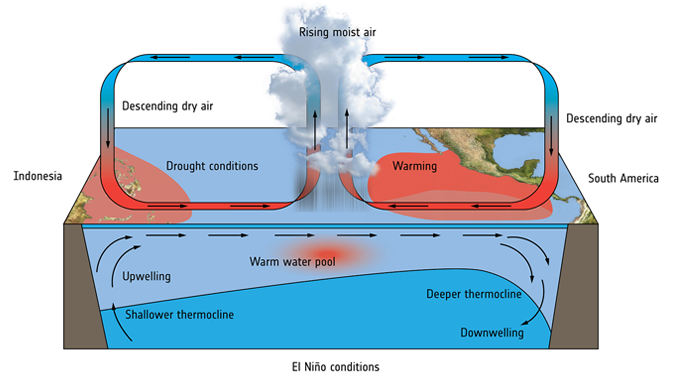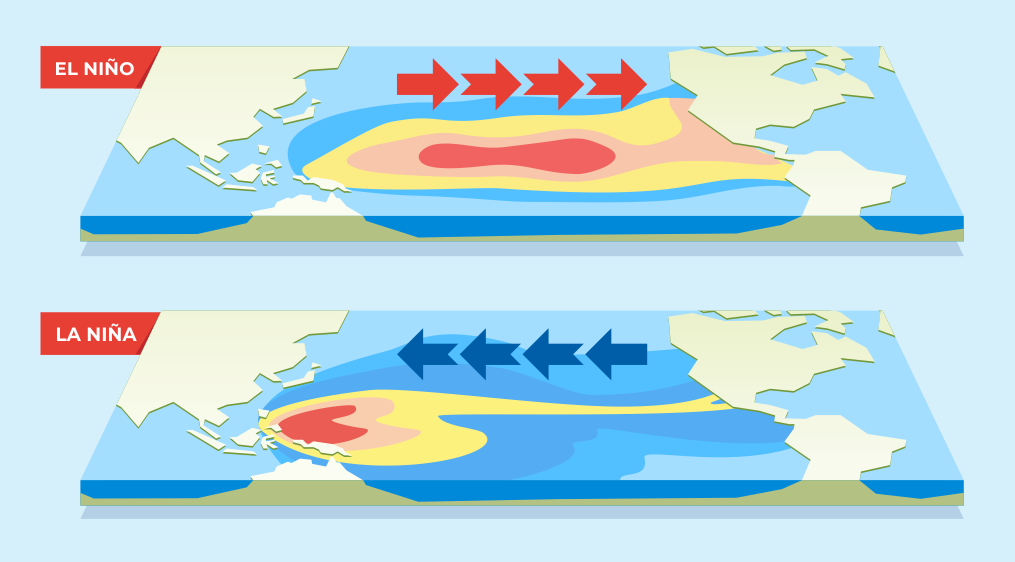Explain the Difference Between El Nino and La Nina
La Niña refers to the periodic cooling of sea-surface temperatures across the east-central equatorial Pacific. El Niño conditions occur when abnormally warm waters.

Summary Of El Nino La Nina Signals In The Marine Physical Environment Download Table
Both patterns tend to happen every 3-7 years and play a big part in how warm or cold US winters will be.

. El Niño and La Niña are the extreme phases of the ENSO cycle. El nino Unusally warm water temps im the oacific cause by a weak or reversed direction trade winds La Niña Unusually cold water temps in the pacific caused by strong easterly winds La Niña characteristics Cooling of the water in the Pacific Ocean Less Precipitation Decreased Humidity Unusually cold weather in Alaska. El NiÃo means little boy while La NiÃa means little girl.
Between these two phases is a third phase called ENSO-neutral. As a matter of fact El Nino is more. It represents the cold phase of the ENSO cycle.
The conditions of El Niño occur when the water on the surface of the. It represents the warm phase of the ENSO cycle. The longest El Nino in the modern record lasted 18 months while.
The main difference between El Nino and La Nina is their weather occurrencesEl Nino occurs in a summer-like fashion while La Nina occurs in a more heavy rain-l. The difference between El Niño and La Niña We believe in Compassionate Humanity Join us in the Fight for Our Childrens Future BECOME AN EO MEMBER TODAY First El Niño means the little boy in Spanish and La Niña the little girl. Scientists call these phenomena the El Niño-Southern Oscillation ENSO cycle.
What Does El Niño and La Niña Mean in Spanish. There will be stronger trade winds and cooler surface water temperatures. When that occurs a fully developed El Nino effect exists.
10 rows Difference between El Nino and La Nina. La Niña is Spanish for Little Girl. One of the important differences between La Nina and El Nino is in connection with the frequency of their occurrence.
El Nino in Spanish means Boy Child La Nina means Girl Child. Derived from the Spanish term which. 1In Spanish El NiÃo stands for child Christ and since this phenomenon would occur around Christmas the name stuck.
El Niño and La Niña are two opposing climate patterns that break these normal conditions. El Niño is translated as Christ Child or Little Boy. It means La Nina occurs due to the fact that the surface of the ocean has its temperature reduced by few Celsius below normal.
Both El Niño and La Niña can last more than a year but it is rare for El Niño events to last longer than a year or so while it is common for La Niña to last for two years or more. El Niño and La Niña can both have global impacts on weather wildfires ecosystems and economies. During El Nino the Southern part of US is unusually cooler while the northern regions become.
2El NiÃo is the more prevalent phenomenon of the two whereas La Nina makes an appearance every few years. The terms El Niño and La Niña refer to periodic changes in Pacific Ocean sea surface temperatures1 that have impacts on weather all over the globe. La Nina on the other stands for little girl and denotes a cold event or a cold episode.
The heat in turn affects atmospheric circulation both in the north-south direction and east-west. These changes in the Pacific Ocean and its overlying atmosphere occur in a cycle known as the El NiñoSouthern Oscillation ENSO. La Nina is the opposite effect when cold ocean pool exists with cold air above.
This means cold event in Spanish. While an El Niño is an anomalous warming of the central and eastern equatorial Pacific ocean a La Niña is an anomalous cooling of the same area. El Niño refers to the above-average sea-surface temperatures that periodically develop across the east-central equatorial Pacific.
Normally strong trade winds blow from the east along the equator pushing warm water into the western Pacific Ocean. Episodes of El Niño and La Niña typically last nine to 12 months but can sometimes last for years. In the Pacific Ocean near the equator temperatures in the surface ocean are normally very warm in the western Pacific and cool in the eastern Pacific2.
El Nino typically involves waters with a warmer than usual surface temperature a flatter thermocline cooler water moves to the surface and weaker trade winds. El NiÃo refers to the warm episode of the oscillation phenomenon while La NiÃa is the cold episode. The location of all that convection is important.
In El Niño because the warm water stays in the. This helps to generate heavy rains over southeastern Asia and. As for La Nina think of it as the opposite of El Nino.
Its a bit of a scientific dance between ocean and atmosphere with the opposite ends of the spectrum known as El Niño the warm phase and La Niña the cold phase. El Niño events are associated with a warming of the central and eastern tropical Pacific while La Niña events are the reverse with a sustained cooling of these same areas. Together these extreme phases are called the El Niño-Southern Oscillation.
What Causes El Niño and La Niña. It is said that El Nino occurs more frequently than La Nina. At times La Niña is also called El Viejo or anti-El Nino.
A fully developed El Nino event occurs when a warm pool of ocean water coincides with a warm pool of air above. The change it causes to Sea Surface Temperatures SST will influence our winter weather. Another one tells that the motion of the atmosphere affects the water in the ocean which makes it heat up just like how engine heats up when being revved up.

Difference Between El Nino And La Nina El Nino Vs La Nina

What Are The Differences Between El Nino And La Nina

El Nino Vs La Nina What S The Difference Earth How

Vol 66 Getting To Know El Nino La Nina Aha Centre The Column
Comments
Post a Comment